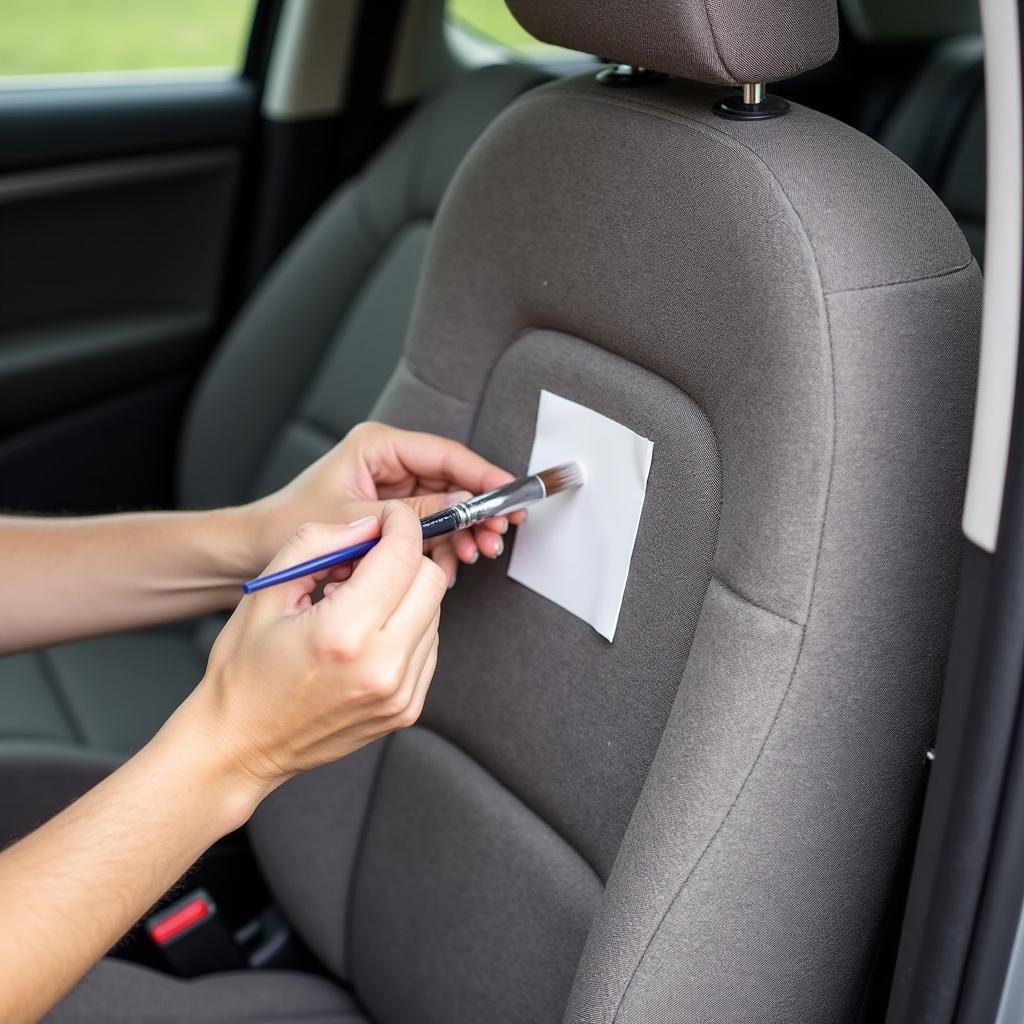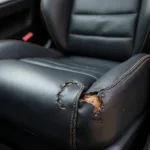A rip in your car’s cloth seat can be an eyesore and detract from the overall appearance of your vehicle’s interior. Fortunately, repairing minor to moderate rips in cloth car seats is often a manageable DIY project. With the right materials and a bit of patience, you can restore your car seats to their former glory and prolong their lifespan.
Assessing the Damage
Before diving into the repair process, it’s crucial to assess the severity of the damage. Small tears or punctures are generally easier to fix than large rips or extensive fraying. Examine the rip closely to determine if it affects the seam or if it’s a clean tear in the fabric. If the damage is extensive or involves complex stitching, seeking professional upholstery repair might be the best course of action.
Gathering Your Supplies
To effectively repair a rip in your cloth car seat, you will need a few essential supplies:
- Upholstery Repair Kit: These kits are readily available online and at auto parts stores. They typically include a variety of colors and grains of fabric to match your car’s interior, adhesive, a backing patch, and often helpful tools like a color blending marker.
- Scissors: Sharp fabric scissors will help you make precise cuts when preparing the repair patch.
- Tweezers: These are handy for tucking in fabric edges and removing any loose threads.
- Clean Cloth: Use a clean cloth to wipe away excess adhesive and keep the repair area clean.
- Optional: If your repair kit doesn’t include a color blending marker, you might want to purchase one separately to help camouflage the repair.
Step-by-Step Repair Guide
Follow these steps to repair a rip in your cloth car seat:
-
Clean the Area: Begin by thoroughly cleaning the area around the rip with a mild cleaner and a clean cloth. Allow the area to dry completely before proceeding.
-
Trim Loose Threads: Using sharp scissors, carefully trim any loose threads around the rip. Avoid pulling or tugging on the fabric, as this can worsen the damage.
-
Prepare the Patch: If your repair kit includes a backing patch, cut it to a size slightly larger than the rip, ensuring it can fully cover the damaged area.
-
Apply Adhesive: Following the instructions on your chosen adhesive (usually included in the repair kit), apply a thin, even layer to the back of the patch and around the underside of the rip.
-
Position the Patch: Carefully align the patch over the rip, ensuring it sits flat against the seat fabric. Press down firmly on the patch for a minute or two, allowing the adhesive to bond.
 Applying a patch to a ripped car seat with adhesive
Applying a patch to a ripped car seat with adhesive
-
Fill the Rip: If the rip is large or has resulted in a significant loss of fabric, you can use a fabric filler from your repair kit to fill the gap. Apply the filler sparingly and use a flat tool, like the back of a spoon, to smooth it out evenly.
-
Blend the Repair: Once the adhesive and filler are dry, use a color blending marker to blend the edges of the patch and any filler with the surrounding fabric. This will help to create a seamless and less noticeable repair.
-
Allow to Cure: Allow the adhesive and filler to cure completely according to the manufacturer’s instructions. Avoid using the seat during this time to prevent the patch from shifting or peeling.
Preventing Future Rips
While a well-executed repair can effectively restore the appearance of your cloth car seats, prevention is always better than cure. Here are a few tips to help prevent future rips:
- Avoid Sharp Objects: Be mindful of what you bring into your car and avoid placing sharp objects, such as pens, tools, or keys, directly on the seats.
- Pet Protection: If you frequently travel with pets, consider using a seat cover or hammock to protect your seats from claws and teeth.
- Regular Cleaning: Regularly cleaning your car seats can help prevent dirt and debris from becoming embedded in the fabric, which can lead to premature wear and tear.
- Careful Entry and Exit: Be mindful when entering and exiting your vehicle, as repeated friction from clothing can weaken the fabric over time.
When to Seek Professional Help
While minor rips and tears in cloth car seats are often manageable DIY projects, certain situations warrant professional upholstery repair. Consider seeking professional help if:
- The rip is extensive or involves complex stitching.
- The fabric is severely damaged or frayed beyond repair.
- The rip affects the structural integrity of the seat.
- You’re uncomfortable attempting the repair yourself.
Conclusion
Repairing rips in cloth car seats is a practical way to maintain the appearance and lifespan of your vehicle’s interior. By following these steps and taking preventative measures, you can keep your car seats looking their best for years to come. Remember to assess the damage carefully and gather the necessary supplies before starting the repair. If you’re unsure about tackling the repair yourself, don’t hesitate to seek professional help.
FAQs
Q: Can I use super glue to repair a rip in my cloth car seat?
A: It’s not recommended to use super glue as it can create a stiff and inflexible bond that may crack or peel over time. Additionally, super glue can be difficult to control and could damage the surrounding fabric.
Q: How long will the repair last?
A: The longevity of the repair depends on the quality of the repair kit, the severity of the rip, and the care taken during the repair process. With proper care, a well-executed repair can last for several years.
Q: Can I wash my car seats after repairing a rip?
A: It’s generally safe to wash your car seats after the repair has fully cured, but it’s essential to follow the care instructions provided with your repair kit and your car’s upholstery. Avoid harsh chemicals or abrasive cleaners that could damage the repair.
Q: My car seat has a burn hole. Can I repair that using the same method?
A: While you can use a similar patching method to address burn holes, keep in mind that it might be more challenging to achieve a seamless finish due to the nature of the damage. You might need to use a larger patch or additional filler to cover the hole effectively.
Q: What if I can’t find a matching color fabric in a repair kit?
A: If you can’t find an exact color match, choose a kit with a color that’s as close as possible to your car’s interior. You can then use a fabric dye or a color blending marker to fine-tune the color and achieve a closer match.
For more information on car seat repair and other car interior maintenance tips, check out our other helpful resources:
- What do car dealerships use to repair leather car seats
- How to repair stained leather car seats
- How to repair torn vinyl car seats
Remember, if you need assistance with more complicated repairs or have any concerns about repairing your car seats yourself, don’t hesitate to contact us via WhatsApp at +1(641)206-8880 or email us at [email protected]. Our team of car care experts is available 24/7 to answer your questions and provide guidance.

